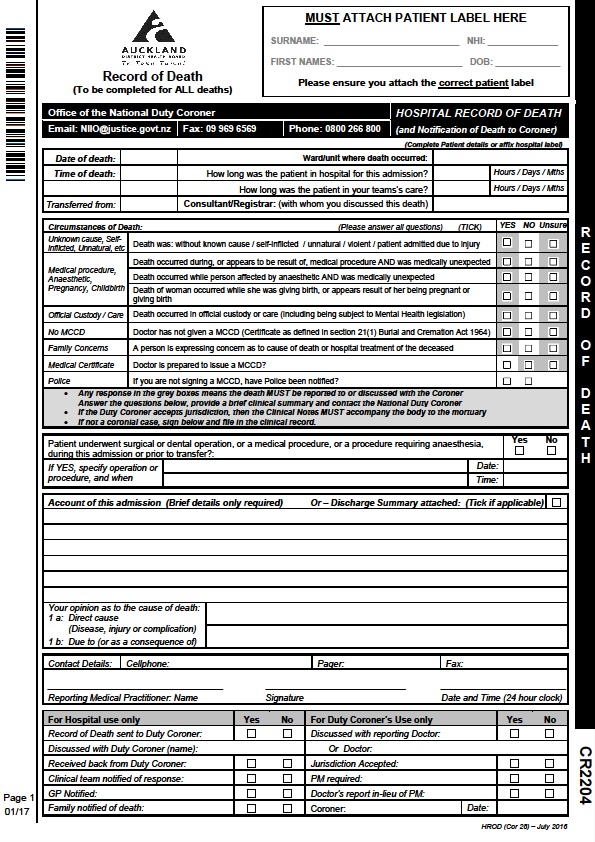Death of a patient
If a patient is expected to die or has died in the ICU then organ or tissue donation should be considered (see above).
The registrars responsibilities following the death of a patient in the ICU include:
Confirmation of death.
Discussion with on call consultant if the death is unexpected. If a death is expected then it is useful to clarify the appropriate documentation for the Medical Certificate of Causes of Death during the ward round.
Determining if a death needs to be referred to the coroner and making this referral if required. If you are unsure if a death requires referral to the coroner then please discuss with the ICU consultant. Some information regarding referral of deaths to the coroner is below and similar information is also on the Hospital Record of Death and the Death Documents website.
Liaising with family.
Completion of death documentation including the Hospital Record of Death (CR2204), Medical Certificate of Causes of Death (HP4720), and Cremation Certificate of Medical Practitioner (CR5741).
The Hospital Record of Death must be completed for all patients. If the death is required to be reported to the coroner then a copy of this must be sent to the coroners office.
The Medical Certificate of Causes of Death and Cremation Certificate of Medical Practitioner can be completed online via the Death Documents website: https://deathdocs.services.govt.nz/.
To use this website you will need a login. You can create a login on the site using your RealMe identification.
Completion of hospital discharge summary.

Information regarding requirements upon the death of a patient is also available in the Te Toka Tumai policy document “Deceased (Tūpāpaku) +/- Referrals to the Coroner for an Adult, Child, Infant, Neonate or Stillbirth”. This is available on the hospital intranet.
Section 3 refers to the medical staff members responsibilities in the event of a death and this is replicated in part below.
3.1.1Where there is uncertainty about the need for a Coroner referral
It is recommended that the registrar or consultant contact the Coroner if there is any doubt as to whether the death should be reported to the coroner. The Coroners welcome discussion about the death of any patient. It is helpful to the Coroners for the discussion to be with a clinician who knew the tūpāpaku/deceased person. Coroner/police contact details are listed below.
S14 (2)(a)-(e) of the Coroners Act 2006 outline deaths that must be reported to a Coroner. A death is required to be reported to a Coroner where:
A doctor determines that the death appears to have been without known cause; or
A doctor determines that the death appears to have been self-inflicted, unnatural, or violent;
The death occurred during, or appears to have been the result of, a medical procedure, and the death was medically unexpected;
The death occurred while the person concerned was affected by an anaesthetic, and the death was medically unexpected;
The death of a woman occurred while the woman was giving birth, or the death appears to have been a result of the woman being pregnant or giving birth;
The death occurred in official custody or care, including, but not limited to, a patient under the Mental Health (Compulsory Assessment and Treatment) Act 1992, a prisoner or a person in the custody of the New Zealand Police.
Please see section 9(a)-(i) of the Coroners Act 2006 for the full list – see Legislation.
A death is medically unexpected if it would not reasonably have been expected by a health practitioner who was competent to carry out the procedure, or administer the anaesthetic, and had knowledge of the deceased’s medical condition before the procedure began.
The circumstances where deaths are required to be reported to the Coroner are set out in the Record of Death (CR2204), which must be completed for all deaths. If a doctor who is well acquainted with the case determines that there is no causative or suspected relationship between the death and a medical procedure, or the administration of anaesthetic, a referral to the Coroner may not be required and the Medical Certificate of Causes of Death HP4720 form may be completed. However, proximity of the procedure or administration of anaesthetic must be a factor in assessing the likelihood of a causative relationship. The Coroner should be contacted in all deaths where there is uncertainty regarding whether or not the death should be referred to the Coroner.